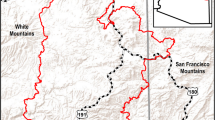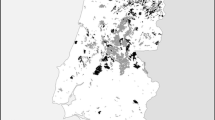Abstract
The purpose of this study is to investigate if, or under what conditions, fires select given land cover types for burning. If fires burn unselectively then the land cover composition (the proportional area of various land cover types) of individual fires should approximate the land cover composition available in their neighborhood. In this study we test this hypothesis by performing statistical analyses of a data set consisting of paired vectors with the proportions of land cover types present in burned areas and in their respective surroundings. The statistical methods employed (a permutation technique and the Cmax statistic) are commonly used in resource selection studies where data is subject to a unit-sum constraint. The results of the analysis of 506 fires that burned in Portugal in 1991 indicate that fires are selective, with small fires exhibiting stronger land cover preferences than large fires. According to the results of a multiple comparison analysis performed for small fires, there is a marked preference for shrubland followed by other forest cover types, while agriculture is clearly avoided. A similar analysis is performed to test if fire selectivity is related to the ecological region where it occurs. The results obtained in this study contribute to the discussion on the relative importance of fuels as a drivers of fire spread.
Similar content being viewed by others
References
J.K. Agee (1997) ArticleTitleThe severe weather wildfire – too hot to handle? Northwest Sci. 71 IssueID1 153–156
J.R. Alldredge J.T. Ratti (1986) ArticleTitleComparison of some statistical techniques for analysis of resource selection J. Wildlife Manage. 50 157–165
J.R. Alldredge J.T. Ratti (1992) ArticleTitleFurther comparison of some techniques for analysis of resource selection J. Wildlife Manage. 56 IssueID1 1–9
J.R. Alldredge D.L. Thomas L.L. McDonald (1998) ArticleTitleSurvey and comparison of methods for study of resource selection J. Agric., Biol. Environ. Statist. 3 IssueID3 237–253
H.E. Anderson (1982) Aids to determining fuel models for estimating fire behavior INT-122, lntermountain Forest and Range Experiment Station Ogden, UT 22
M.E. Biondini P.W. Mielke E.F. Redente (1991) Permutation techniques based on Euclidean analysis : a new and powerful statistical method for ecological research (Chapter 19) L. Orloci E. Feoli (Eds) Computer Assisted Vegetation Analysis Kluwer Academic Publishers DordrechtThe Netherlands 221–240
S. Bunting F. Rego (1988) ArticleTitleHuman impact on Portugal's vegetation Rangelands 10 IssueID6 251–255
Brian Cade S. Jon Richards D. (2001) User manual for Blossom statistical software Midcontinent Ecological Science CenterU.S. Geological Survey ColoradoUSA 111
Commission Europé enne 2001. Systé me communautaire d'informations sur les incendies de forêts. Rapport 2001, Donné es 1985–1999, 84 pp. http://europa.eu.int/comm/agriculture/fore/fires/reports/2001_fr.pdf.
CNIG 1990. COS'90, Carta de Ocupação do Solo de Portugal continental. http://www.igeo.pt/IGEO/portugues/produtos/CEGIG/COS.htm
S.G. Cumming (2001) ArticleTitleForest type and wildfire in the Alberta boreal mixedwood: what do fires burn? Ecol. Appl. 11 IssueID1 97–110
Nairanjana Dasgupta Richard Alldredge (1998) ArticleTitleA multivariate χ2 analysis of resource selection data J. Agric. Biol. Environ. Statist. 3 IssueID3 323–334
Nairanjana Dasgupta Richard Alldredge (2002) ArticleTitleA single-step method for identifying individual resources J. Agric., Biol., Environ. Statist. 7 IssueID2 208–221
R. Díaz-Delgado Xavier Pons (2001) ArticleTitleSpatial patterns of forest fires in Catalonia (NE of Spain) along the period 1975–1995: analysis of vegetation recovery after fire Forest Ecol. Manage. 147 67–74 Occurrence Handle10.1016/S0378-1127(00)00434-5
DGF (2001) Inventário Florestal Nacional: Portugal Continental, 3a Revisão Direcção-Geral das Florestas Lisboa Portugal 233
E. Keeley Jon C.J. Fotheringham M. Morais (1999) ArticleTitleReexamining fire suppression impacts on brushland fire regimes Science (in reports) 284 1829–1832
E. Keeley Jon C.J. Fotheringham (2003) ArticleTitleImpact of pastpresentand future fire regimes on North American Mediterranean shrublands. Fire and climatic change in temperate ecosystems of the Western Americas Ecol. Stud. 160 218–262
Manique J. and De Pina e Albuquerque 1985. Esta¸õ Agronómica Nacional. http://195.22.0.189/atlas/index. Manly L., McDonald and Thomas D.L. 1993. Resource
L. Manly McDonald D.L. Thomas (1993) Resource Selection by Animals: Statistical Design and Analysis for Field Studies Chapman & Hall New York, USA
S.A. McClean M.A. Rumble R.M. King W.L. Baker (1998) ArticleTitleEvaluation of resource selection methods with different definitions of availability J. Wildlife Manage. 62 IssueID2 793–801
W. Mielke Paul (1986) ArticleTitleNon-metric statistical analyses: some metric alternatives J. Statist. Plan. Infer. 13 377–387 Occurrence Handle10.1016/0378-3758(86)90147-3
W. Mielke Paul J. Berry Kenneth (2001) Permutation Methods: A Distance Function Approach Springer-Verlag NY, USA
R.A. Minnich (1983) ArticleTitleFire mosaics in southern California and northern Baja California Science 219 1287–1294
R.A. Minnich Y.H. Chou (1997) ArticleTitleWildland fire patch dynamics in the chaparral of southern California and northern Baja California Int. J. Wildland Fire 7 221–248
F. Moreira F.C. Rego P.G. Ferreira (2001) ArticleTitleTemporal (1958–1959) pattern of change in a cultural landscape of northwestern Portugal: implications for fire occurrence Landscape Ecol. 16 557–567 Occurrence Handle10.1023/A:1013130528470
J.M. Moreno (1999) Forest fires: trends and implications in desertification prone areas of Southern Europe P. Balabanis D. Peter A. Ghazi M. Tsogas (Eds) Mediterranean Desertification: Research Results and Policy Implications 1 DG Research European Commission EUR 115–150
M.A. Moritz (2003) ArticleTitleSpatio-temporal analysis of controls on shrubland fire regimes: age dependency and fire hazard Ecology 84 IssueID2 351–361
M.A. Moritz J.E. Keeley E.A. Johnson A.A. Schaffner (2004) ArticleTitleTesting a basic assumption of shrubland fire management: how important is fuel age? Front. Ecol. Environ. 2 IssueID2 67–72
C.D.S. Nogueira (1990) ArticleTitleA floresta PortuguesaDGF Informação 2 18–28
A. Pena J. Cabral (1996) Roteiros da Natureza Temas e Debates LisboaPortugal
J.M.C. Pereira T.N. Santos (2003) Fire risk and burned area mapping in Portugal Direcção Geral das Florestas LisboaPortugal
Pereira M.G., Trigo R.M., Camara Carlos C., Pereira J.M.C. and Leite S.M. in press. Synoptic patterns associated with large summer forest fires in Portugal. Agric. Forest Meteorol.
Francisco Rego (1992) Land use change and wildfires A. Teller P. Mathy J.N.R. Jeffers (Eds) Responses of Forest Ecosystems to Environmental Changes Elsevier Applied Science London, UK 367–373
R.C. Rothermel C.W. Philpot (1973) ArticleTitlePredicting changes in chaparral flammability J. Forest. 71 640–643
J.P. Serra (1982) Image Analysis and Mathematical Morphology Academic Press London, UK
J.M. Silva (1990) ArticleTitleLa gestion forestiére et la silviculture de prevention des espaces forestiers menacés par les incendies au Portugal Rev. Forest. Française 40(n° spécial) 337–345
T. Silva (2004) Estimativa das emissões atmosféricas originadas por incêndios em Portugal continental ao longo do período entre 1990 e 1999 Universidade Técnica de Lisboa Portugal 86
M.J.P. Vasconcelos S. Silva M. Tomé M. Alvim J.M.C. Pereira (2001) ArticleTitleSpatial prediction of fire ignition probabilities: comparing logistic regression and neural networks Photogrammet. Eng. Remote Sens. 67 IssueID1 73–81
R.M. Vélez (2000) Combustibles Forestales: Combustibilidad La Defensa Contra Incêndios Forestales. Fundamentos y Experiências McGraw-Hill, MadridSpain 7.1–7.16
J.H. Zar (1999) Biostatistical Analysis Prentice-Hall Inc. New Jersey, USA
Author information
Authors and Affiliations
Corresponding author
Rights and permissions
About this article
Cite this article
Nunes, M., Vasconcelos, M., Pereira, J. et al. Land Cover Type and Fire in Portugal: Do Fires Burn Land Cover Selectively?. Landscape Ecol 20, 661–673 (2005). https://doi.org/10.1007/s10980-005-0070-8
Received:
Accepted:
Issue Date:
DOI: https://doi.org/10.1007/s10980-005-0070-8




